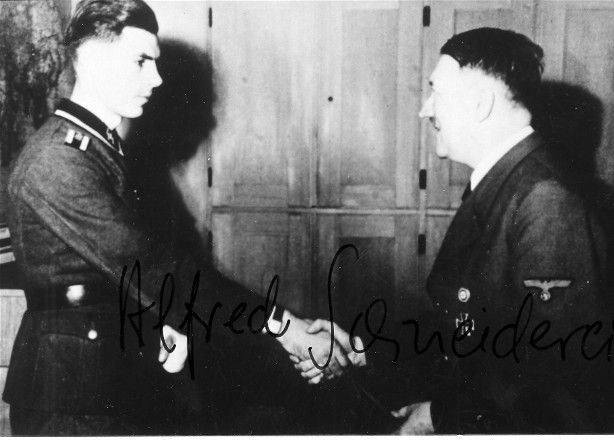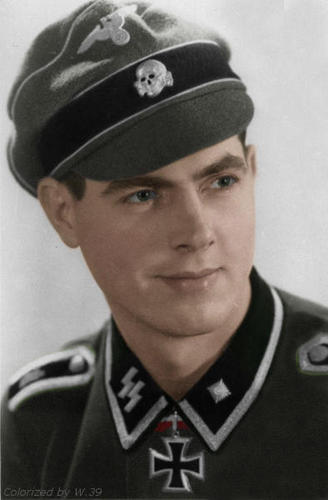Schneidereit, Alfred (SS-Pz.Gren.Reg. 1)
- Date of birth:
- October 29th, 1919 (Insterburg/Eastern Prussia, Germany)
- Date of death:
- February 21st, 1999 (Donauwörth/Bavaria, Germany)
- Service number:
- SS-Nr.: 362.681 // NSDAP-Nr.:
- Nationality:
- German
Biography
On the 15 November 1939, he joined the SS-Verfügungstruppe and was posted to the 18th Company of Leibstandarte SS Adolf Hitler Regiment.
He was attached to the Guard Battalion in Berlin and did not see active service in the Polish Campaign or the Battle of France.
Then in 1940 he was posted to the 8th Company LSSAH in time for the Balkans Campaign. After the Balkans the LSSAH was moved to the east for Operation Barbarossa where Schneidereit was involved in the battles at Lutsk, Kherson, Taganrog and Rostov. In 1942 - 1943 the Division was sent to France to refit and Schneidereit now in the 8th Company, II./1st SS-Panzer Grenadier Regiment, returned to the Eastern Front to participate in the Third Battle of Kharkov, where Schneidereit was awarded the Infantry Assault Badge in Bronze.
For his part in Operation Citadel he was awarded the Close Combat Clasp in Bronze and the Wound Badge in Black.
In November 1943 Schneidereit's Division was returned to the Eastern Front for the Battle of Kursk where he was wounded twice more and was awarded the Iron Cross 1st class and the Knight's Cross from Adolf Hitler. Schneidereit, in command of a Panzerschreck anti-tank weapon knocked out five T34 tanks and two personnel carriers and also commanded a counterattack against Russian Infantry that was threatening to overrun his company's position.
Schneidereit was also promoted to Scharführer (Staff Sergeant) for bravery in the face of the enemy, and posted to the officer training school at Bad Tölz, 6. Lehrgang für versehrte SS-Führerbewerber z.V., SS-Junkerschule Tölz, which he graduated from in October 1944 as a senior officer candidate (SS-Standartenoberjunker). In January 1945, he was promoted to SS-Untersturmführer (Second Lieutenant) and from April - May 1945, was involved in operations east of Berlin as a company commander within the replacement battalion LSSAH. Once again he was wounded and surrendered to the Russians on 12 May 1945.
Do you have more information about this person? Inform us!
- Period:
- Second World War (1939-1945)
- Awarded on:
- August 1942
- Period:
- Second World War (1939-1945)
- Awarded on:
- August 6th, 1942
- Period:
- Second World War (1939-1945)
- Awarded on:
- 1943
- Period:
- Second World War (1939-1945)
- Awarded on:
- August 1943
- Period:
- Second World War (1939-1945)
- Awarded on:
- October 1943
- Period:
- Second World War (1939-1945)
- Awarded on:
- November 12th, 1943
- Period:
- Second World War (1939-1945)
- Awarded on:
- November 1943
- Period:
- Second World War (1939-1945)
- Rank:
- SS-Unterscharführer (Sergeant)
- Unit:
- SS-Panzer-Grenadier-Regiment 1, 1. SS-Panzergrenadier-Division “Leibstandarte SS Adolf Hitler”, Heeresgruppe Süd
- Awarded on:
- December 20th, 1943
"SS-Rottenführer Alfred Schneidereit, 8./SS-Panz.Gren.Rgt.1 "LSSAH", was first assigned to the field troop of the LSSAH in November 1939 and was utilized as an infantryman (MG squad and messenger). He was deployed in Greece, the Russian campaign 1941/42, the Third Battle of Kharkov, the battle of Kursk and the occupation of Italy and has applied himself with complete bravery.
For his attitude and special achievements he has been decorated with the Iron Cross Second Class and the Close Combat Clasp in Bronze. The Second Class Iron Cross was awarded on the 06.08.1942 whilst he was employed with the Division in France, and the honour of the Iron Cross First Class came after the New Year and the summer fighting of 1943.
After the fighting along the railway line Kasatin-Fastoff on the 12.11.1943, starting north of the railway from Kornin, he was assigned with his Kompanie and proved himself again with the use of his anti-tank rifle on the battlefield, being decorated with the Iron Cross First Class.
On the 18.11.1943 the 8. Kompanie was the spearhead during the battle at Kotscherowo, and were deployed east of the main road from Shitomir-Kiev. Schneidereit was the anti-tank rifle Troop Leader and he advanced with his anti-tank rifle and inserted himself in the lead. The first of eight attacks put in against the positions of the I. & II. Battalions/SS-Panz.Gren.Rgt. 1 by the Russians were supported by 6 T-34s, with the latter firing their high explosive shells from a long range. Schneidereit's firing position was recognized and was shot at by an enemy tank. Schneidereit allowed the tanks to roll up to within sixty metres and then attacked this T-34, but then another enemy tank destroyed his anti-tank rifle with a direct hit with fragments of this caused him head wounds. His position was then rolled up by another tank.
Schneidereit collected his Troop and placed it on the edge of the Kompanie. Since the Kompanie Leader was wounded during this attack, he made the independent decision to lead the Zug and begin a further attack. Although there were still four enemy tanks firing in front of their positions, he succeeded with his Zug in taking back the high ground from the enemy infantry as well as the old positions of the Kompanie. As a result of this attack, the rest of the Kompanie and the neighbouring Kompanie were able to restore the original position.
The next battle wasn't long in coming and after two hours the Russians starting attacking again with infantry and tanks, but Schneidereit halted them in front of his position and forced the infantry to ground. They tried again with the covering support of three T-34s in the rear. It was during this attack that all of the Führer and Unterführer fell. Schneidereit took overall lead of the Kompanie and gathered the remaining men together. With these men he then began to attack into the flank of this enemy attack. During this attack, he was wounded by shell splinters in his left hand and it was almost severed (the fingers in the middle of this hand will probably be lost). Despite his injuries, he alone made it possible for the remainder of the Kompanie to take up their old positions.
As a result of his two attacks, which reached the open flank of the Russian infantry, the left neighbouring Kompanie gave up and moved themselves to the rear. With both of these attacks and by his independent resolution, through which he made the decision to employ the Kompanie with all of his willpower, he once again brought us into the old positions and prevented the rolling up of the Battalion flank to the rear.
I hold that SS-Rottenführer Schneidereit, through his personal attitude, his record with his Troop, and his proven bravery in the field of battle as described above (all on account of his own resolve), is worthy of the high honour of the award of the Knight's Cross to the Iron Cross. I please ask that he be awarded this."
- Period:
- Second World War (1939-1945)
- Unit:
- 8./ SS-Pz.Gren.Rgt. 1
Sources
- Photo 1: Willi Schumacher Collection
- Photo: Willi Schumacher Collection
- Colorizations By Users - Waffen-ϟϟ Unterscharführer Alfred Schneidereit
- - MOONEY, PETER, Waffen-SS Knights and their Battles, Schiffer Publishing, Ltd., 2012.
- schneidereit alfred.JPG.
- Schneider J.W., Their Honor was Loyalty!, R. James Bender Publishing, 1977
- LSSAH Tank Destruction Badge Holders - Wehrmacht-Awards.com Militaria Forums












